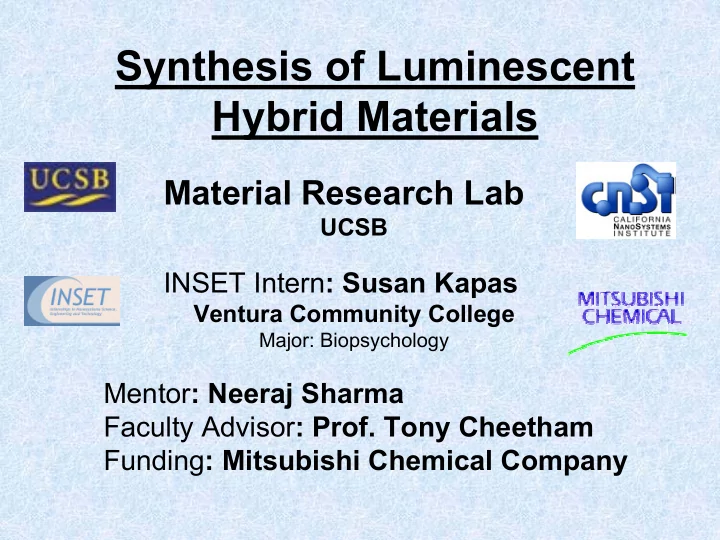

Synthesis of Luminescent Hybrid Materials Material Research Lab UCSB INSET Intern : Susan Kapas Ventura Community College Major: Biopsychology Mentor : Neeraj Sharma Faculty Advisor : Prof. Tony Cheetham Funding : Mitsubishi Chemical Company
REASON FOR THE RESEARCH •Hg-based fluorescent lamps 254nm Hg Phosphor visible Environmental pollution; Decrease power Why change? consumption; Longer life •Future /Upcoming Tech GaN Hybrid GaN 360nm- visible Material 400nm
Objective: •To Make Luminescent Inorganic- Organic Hybrid Materials Approach: •Synthesis of materials containing lanthanide ions (La, Gd) by hydrothermal synthesis •Studying luminescent properties of doped compounds
HYDROTHERMAL SYNTHESIS •What is Hydrothermal Synthesis? -Moderate Temperature -Autogenous Pressure •PROCEDURE: pTFE - Combining reactants - Autoclave Stainless - Heat 200°C ~ 2,3 days steel - Filter Material
Synthesized Samples: Characterization: •Single-crystal X-ray diffraction •Powder X-ray diffraction •Thermogravimetric Analysis •Photoluminescence
Powder X-ray diffraction DETECTOR Bragg’s Law: n λ =2d(sin θ ) SAMPLE PLATFORM X-RAY SOURCE •Cu source ( λ = 1.5418 Å)
Powder XRD scan XRD SK04 900 800 700 600 500 C/sec 400 300 200 100 0 5 7 9 11 13 15 17 19 21 23 25 27 29 2Theta
Single Crystal X-ray diffraction SK04 1mmol La(NO 3 ) 3 .6H 2 O : 2mmol 5-sulfo-isophthalic acid Water, NaOH T = 180°C/2days a = 7.1669(10) Å b = 8.3139(12) Å c = 16.8519(24) Å β = 97.5 ° •Mo source ( λ = 0.71073Å) •0.1x 0.1 x 0.08mm
LUMINESCENCE .95mmol La(NO 3 ) 3 .6H 2 O : 2mmol 5-sulfo-isophthalic acid .05mmol Europium(II) nitrate pentahydrate (SK29) .05mmol Terbium(III) SK29 SK30 No illumination nitrate pentahydrate (SK30) Goal: R(Eu) + G(Tb) + B(Ce) = White light SK29 UV Exc = 365nm SK30
Photoluminescence EXCITATION SOURCE MONOCHRO- MATOR EMISSION SAMPLING MONOCHRO- AREA MATOR DETECTOR READ- OUT
Achievements : • Synthesized new hybrid materials • Determined the single crystal structure of Lanthanum 5- sulfoisophthalate • Studied the luminescent properties of Lanthanum 3,4- pyridinedicarboxylate doped with Eu and Tb. Future plans: • Study the structure and luminescent properties of other hybrid materials • Explore the thermal properties of some of them • Hopefully make the world glow through my materials
Acknowledgements • INSET program (Trevor Hirst, Nick Arnold, Mike Northen) • MRL (Prof. Tony Cheetham, Neeraj Sharma, Grady Snyder) • Funding (Mitsubishi Chemical Company, CNSI, NSF)
Bragg’s Law θ – the scattering angle n – an integer representing the order of the diffraction d - distance http://www.mrl.ucsb.edu/mrl/centralfacilities/xray/xray-basics/Xray-basics.html
Recommend
More recommend